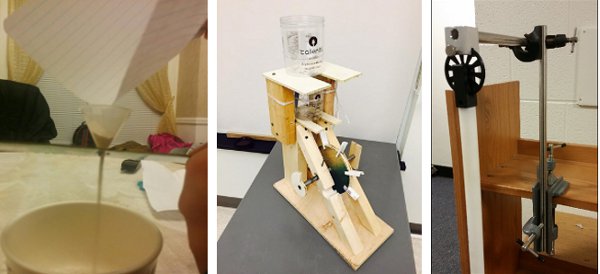A few years ago, I taught one of our "SRS" classes, which are supposed to introduce students to research at the college level-- I blogged about it while the course was in progress. I taught it again in the recently-concluded Winter term, but didn't blog much about it because I was mostly doing the same stuff as last time. I did re-adjust the content a little, as I've changed some things about the way I like to present stuff since 2012, but they were mostly cosmetic tweaks, with one big exception.
In the previous round, I went with the base course description, which just specifies that students must write a research paper, and ended up getting 17 library research papers. Most of which were very well done, but there's only so many library research papers I can read. This time, having had a number of arguments about whether this is really a "research methods" course, I opted instead to require final projects. Since I'm a scientist, and science is about empirical measurements of things, I insisted that every student had to select a project related to timekeeping in which they made an empirical measurement of... something related to timekeeping.
I was a little nervous about this, because it's a slightly unusual kind of assignment, and I wasn't sure how it would go over. And I was also slightly concerned that I would get a dozen variants of experiments we did or discussed in class. But, on the whole, I was extremely impressed with both the quality and the range of the projects I got.
The "featured image" up top (and reproduced below for the RSS crowd) shows a few snapshots from the final papers, showing some of my favorite results. On the left, we have a student who decided to test the performance of different materials for a sandglass, who saw a mention of powdered eggshell as a material in one of the papers we read in class, and made powdered eggshells to test (which turns out to be a multi-step process...). In the center, we have a homemade water wheel clock, with two reservoirs using an overflow system to maintain a constant level in the second, and the outflow from that powering a wheel whose time he tracked. And on the right, we have a plastic pendulum constructed by a woman who chose to take advantage of this awful winter's weather, to measure the effect of thermal expansion on the period by recording the period indoors and outside on a bitter cold day.
 Student projects from my SRS (L to R): Measuring the flow of powdered eggshell in a "sand timer," a homemade water wheel clock, and a pendulum to measure the effect of thermal expansion.
Student projects from my SRS (L to R): Measuring the flow of powdered eggshell in a "sand timer," a homemade water wheel clock, and a pendulum to measure the effect of thermal expansion.
Not pictured are another water clock, an analog metronome, a guy who compared three quartz watches at different temperatures, and another guy who bought a mechanical pocket watch and tracked its performance. We did have several sundials, but those were generally well-done as well, and each of the students working with sundials found a unique approach.
So, on the whole, a very positive experience. Five stars, would do again. I don't know how this will play out in terms of course comments from the students-- those are held up for a couple of weeks because computers-- but a couple of the students did append nice notes with their final papers saying "Thanks for having us build something, I really enjoyed it." And as a faculty member, that's a great feeling.
This term, I'm teaching intro calculus-based classical mechanics for the first time in a few years; two sections of it, no less. Which is going to be grueling, but there's a sabbatical waiting at the end of it, so I'll get through...

I wonder if they were really telling you that they are as tired of writing research papers as you are of reading them!